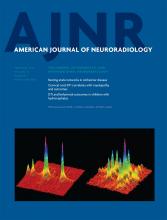Index by author
Vinuela, F.
- NeurointerventionOpen AccessMiddle Cranial Fossa Sphenoidal Region Dural Arteriovenous Fistulas: Anatomic and Treatment ConsiderationsZ.-S. Shi, J. Ziegler, L. Feng, N.R. Gonzalez, S. Tateshima, R. Jahan, N.A. Martin, F. Viñuela and G.R. DuckwilerAmerican Journal of Neuroradiology February 2013, 34 (2) 373-380; DOI: https://doi.org/10.3174/ajnr.A3193
Vishwas, M.S.
- Pediatric NeuroimagingYou have accessDiffusion Tensor Analysis of Pediatric Multiple Sclerosis and Clinically Isolated SyndromesM.S. Vishwas, B.C. Healy, R. Pienaar, M.P. Gorman, P.E. Grant and T. ChitnisAmerican Journal of Neuroradiology February 2013, 34 (2) 417-423; DOI: https://doi.org/10.3174/ajnr.A3216
Wagner, M.
- BrainYou have accessThe U Sign: Tenth Landmark to the Central Region on Brain Surface Reformatted MR ImagingM. Wagner, A. Jurcoane and E. HattingenAmerican Journal of Neuroradiology February 2013, 34 (2) 323-326; DOI: https://doi.org/10.3174/ajnr.A3205
Wallner, A.
- NeurointerventionYou have accessComparison of Stent-Retriever Devices versus the Merci Retriever for Endovascular Treatment of Acute StrokeE. Broussalis, E. Trinka, W. Hitzl, A. Wallner, V. Chroust and M. Killer-OberpfalzerAmerican Journal of Neuroradiology February 2013, 34 (2) 366-372; DOI: https://doi.org/10.3174/ajnr.A3195
Wang, X.
- BrainOpen AccessReduced Regional Gray Matter Volume in Patients with Chronic Obstructive Pulmonary Disease: A Voxel-Based Morphometry StudyH. Zhang, X. Wang, J. Lin, Y. Sun, Y. Huang, T. Yang, S. Zheng, M. Fan and J. ZhangAmerican Journal of Neuroradiology February 2013, 34 (2) 334-339; DOI: https://doi.org/10.3174/ajnr.A3235
Wang, Y.-H.
- FELLOWS' JOURNAL CLUBNeurointerventionYou have accessProspective Comparison of Angio-Seal versus Manual Compression for Hemostasis after Neurointerventional Procedures under Systemic HeparinizationH.-F. Wong, C.-W. Lee, Y.-L. Chen, Y.-M. Wu, H.-H. Weng, Y.-H. Wang and H.-M. LiuAmerican Journal of Neuroradiology February 2013, 34 (2) 397-401; DOI: https://doi.org/10.3174/ajnr.A3226
This article addresses the utility of Angio-Seal versus manual hemostasis in anticoagulated patients following neurointerventional procedures. In a study of 174 punctures, 104 were closed with Angio-Seal and the rest with manual compression. All patients had activated clotting time values between 250–500 seconds at the time of closure. Mean hemostasis times were significantly longer with manual compression and hematomas 3 times more common. Using Angio-Seal led to arterial occlusion in 1 patient who was successfully revascularized. Thus, Angio-Seal is fast and effective in this setting.
Weber, M.
- Pediatric NeuroimagingYou have accessMR Spectroscopy of the Fetal Brain: Is It Possible without Sedation?V. Berger-Kulemann, P.C. Brugger, D. Pugash, M. Krssak, M. Weber, A. Wielandner and D. PrayerAmerican Journal of Neuroradiology February 2013, 34 (2) 424-431; DOI: https://doi.org/10.3174/ajnr.A3196
Weill, A.
- NeurointerventionYou have accessCanadian Experience with the Pipeline Embolization Device for Repair of Unruptured Intracranial AneurysmsC.J. O'Kelly, J. Spears, M. Chow, J. Wong, M. Boulton, A. Weill, R.A. Willinsky, M. Kelly and T.R. MarottaAmerican Journal of Neuroradiology February 2013, 34 (2) 381-387; DOI: https://doi.org/10.3174/ajnr.A3224
Weng, H.-H.
- FELLOWS' JOURNAL CLUBNeurointerventionYou have accessProspective Comparison of Angio-Seal versus Manual Compression for Hemostasis after Neurointerventional Procedures under Systemic HeparinizationH.-F. Wong, C.-W. Lee, Y.-L. Chen, Y.-M. Wu, H.-H. Weng, Y.-H. Wang and H.-M. LiuAmerican Journal of Neuroradiology February 2013, 34 (2) 397-401; DOI: https://doi.org/10.3174/ajnr.A3226
This article addresses the utility of Angio-Seal versus manual hemostasis in anticoagulated patients following neurointerventional procedures. In a study of 174 punctures, 104 were closed with Angio-Seal and the rest with manual compression. All patients had activated clotting time values between 250–500 seconds at the time of closure. Mean hemostasis times were significantly longer with manual compression and hematomas 3 times more common. Using Angio-Seal led to arterial occlusion in 1 patient who was successfully revascularized. Thus, Angio-Seal is fast and effective in this setting.
Wielandner, A.
- Pediatric NeuroimagingYou have accessMR Spectroscopy of the Fetal Brain: Is It Possible without Sedation?V. Berger-Kulemann, P.C. Brugger, D. Pugash, M. Krssak, M. Weber, A. Wielandner and D. PrayerAmerican Journal of Neuroradiology February 2013, 34 (2) 424-431; DOI: https://doi.org/10.3174/ajnr.A3196








